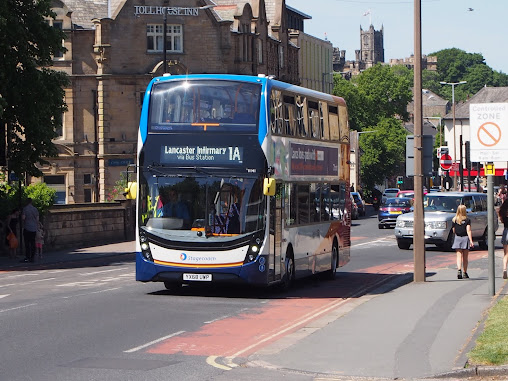The emergency government funding that has been keeping England's bus companies alive was due to run out on 3rd August. Thankfully, but not entirely unexpectedly, the government announced a week later that it was being extended and that an additional £218.4m has been made available to support bus services up until the end of September. After that date it will continue at the rate of £27.3m per week "for as long as it is required". In return, the bus industry is expected to offer a full timetable on all services by the begining of September.
Why is it needed?
Bus operators in England, as in the rest of the UK, are very largely dependent on revenue from fares paid and reimbursement for passes used by passengers, with grants and subsidies from national and local government making up only a small proportion of their income. Passenger numbers fell for several reasons. The imposition of "lockdown" restrictions in late March and the closure of schools, shops and workplaces reduced the need for travel. All bus operators made significant reductions to service levels and social-distancing rules applied to buses reduced their capacity by 75% raising concerns that passengers, such as key workers, who really needed to travel would be unable to do so unless others were deterred from using the bus. The government therefore began a campaign to dissuade people from using public transport and promoting alternatives - including the private car!
 |
| Service 1A was cut back to terminate at the Infirmary as part of the service reductions in March |
Throughout the pandemic the government's messaging has been confusing and unclear and in the public mind "Avoid Public Transport" (to leave room for others) became seen as a message that buses and trains were unsafe and should be avoided on health grounds, despite there being no evidence that public transport is a significant source of infection, and this was reflected in the passenger figures.
Department for Transport figures show that the decline in ridership was sudden and swift. On Monday, 9th March patronage was running as just above "normal" levels, but by the weekend it had dropped to 85%. By Friday, 20th March ridership was down to 53% of normal and following "lockdown" on 23rd March passenger numbers fell off a cliff to just 14% of pre-Covid levels.
Start of Recovery
Numbers bounced along the bottom, between 10 and 12% of "normal", throughout April and May, during which time the government's "avoid the bus" messaging continued and service levels were significantly reduced. During June, some operators, including Stagecoach Cumbria & North Lancs, began to re-instate normal timetables and passenger numbers began a slow recovery. At the end of May, ridership was 15% of normal, but by the end of June this had improved to 26%.
 |
| An almost-deserted Lancaster bus station in May 2020 |
In early July, after a campaign by the bus industry and passenger groups including Lancaster BUG, the government dropped its "avoid the bus" messaging and social-distancing guidelines were changed to allow buses to carry up to 50% of their full capacity. Meanwhile, face coverings had become mandatory on buses from 15th June. This, and the easing of lockdown restrictions, led to an improvement in patronage to 37% by the end of the month.
On 19th July, Lancashire County Council introduced a number of new Sunday bus services in our area and it is noticeable that the recovery in passenger numbers has been swifter at weekends than during the week. Whereas Monday to Friday patronage has recovered to 37% , the weekends have seen improvements to between 45 and 49% of normal weekend traffic. This suggests that leisure and recreational passengers are coming back to the buses more quickly than shoppers and workers, whilst the continued closure of schools and colleges continues to depress weekday demand.
The Future?
All figures quoted are for England (outside London) as a whole and don't specifically relate to Lancaster. They are based on information collected by electronic ticket machines fitted to the buses of a number of major operators, including First, Go-Ahead and Arriva, but not Stagecoach, so they may not accurately reflect our local situation.
It is clear however, that with revenue at less than 50% and costs at almost 100%, financial support for the bus industry is still absolutely necessary if it is to survive and recover. The £27.3m weekly payments offered by government "for as long as it is required" is therefore very welcome although the BUG has to ask exactly who is going to decide whether it is required and what crieria they will use to assess that.
With buses still restricted to allowing only 50% (at most) of seats to be used any continued recovery of passenger levels above the 37% to 49% currently being experienced nationally is bound to lead to problems of accommodation at some point, with more passengers being unable to board their chosen bus. The return of schoolchildren to class in September (assuming it happens) is being catered for by further, separate, government funding for additional school buses with official Guidance as to how this will operate expected to be published soon. Perhaps more importantly for Lancaster, someone, somewhere, is giving some thought to what will happen in October when Universities return and how buses restricted to 50% of normal capacity will cater for the thousands of daily journeys made between the city and University in normal times.
 |
| Will we see scenes like this in 2020? |
.png)
